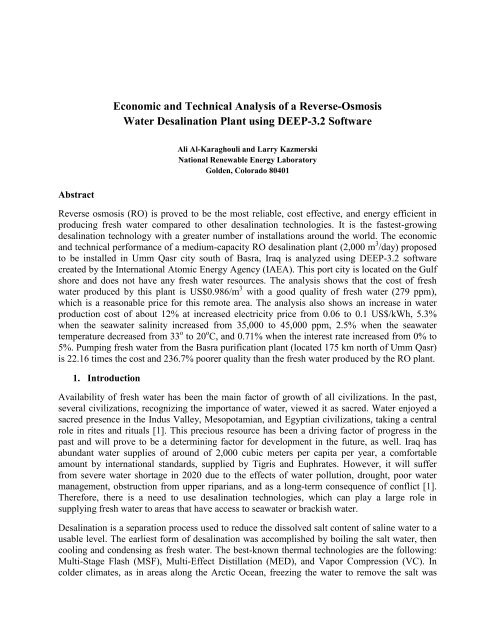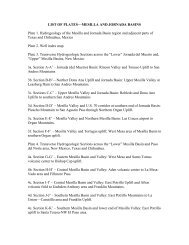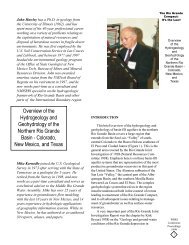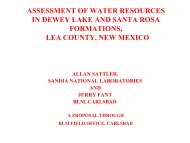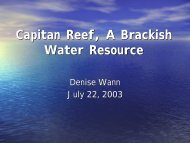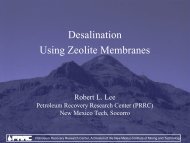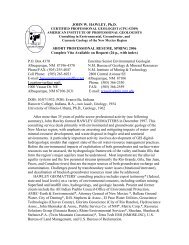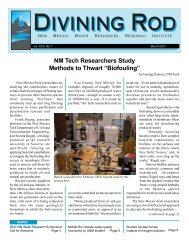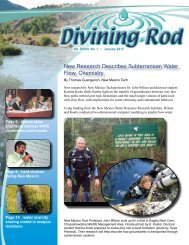Economic and Technical Analysis of a Reverse-Osmosis Water ...
Economic and Technical Analysis of a Reverse-Osmosis Water ...
Economic and Technical Analysis of a Reverse-Osmosis Water ...
You also want an ePaper? Increase the reach of your titles
YUMPU automatically turns print PDFs into web optimized ePapers that Google loves.
<strong>Economic</strong> <strong>and</strong> <strong>Technical</strong> <strong>Analysis</strong> <strong>of</strong> a <strong>Reverse</strong>-<strong>Osmosis</strong><strong>Water</strong> Desalination Plant using DEEP-3.2 S<strong>of</strong>twareAli Al-Karaghouli <strong>and</strong> Larry KazmerskiNational Renewable Energy LaboratoryGolden, Colorado 80401Abstract<strong>Reverse</strong> osmosis (RO) is proved to be the most reliable, cost effective, <strong>and</strong> energy efficient inproducing fresh water compared to other desalination technologies. It is the fastest-growingdesalination technology with a greater number <strong>of</strong> installations around the world. The economic<strong>and</strong> technical performance <strong>of</strong> a medium-capacity RO desalination plant (2,000 m 3 /day) proposedto be installed in Umm Qasr city south <strong>of</strong> Basra, Iraq is analyzed using DEEP-3.2 s<strong>of</strong>twarecreated by the International Atomic Energy Agency (IAEA). This port city is located on the Gulfshore <strong>and</strong> does not have any fresh water resources. The analysis shows that the cost <strong>of</strong> freshwater produced by this plant is US$0.986/m 3 with a good quality <strong>of</strong> fresh water (279 ppm),which is a reasonable price for this remote area. The analysis also shows an increase in waterproduction cost <strong>of</strong> about 12% at increased electricity price from 0.06 to 0.1 US$/kWh, 5.3%when the seawater salinity increased from 35,000 to 45,000 ppm, 2.5% when the seawatertemperature decreased from 33 o to 20 o C, <strong>and</strong> 0.71% when the interest rate increased from 0% to5%. Pumping fresh water from the Basra purification plant (located 175 km north <strong>of</strong> Umm Qasr)is 22.16 times the cost <strong>and</strong> 236.7% poorer quality than the fresh water produced by the RO plant.1. IntroductionAvailability <strong>of</strong> fresh water has been the main factor <strong>of</strong> growth <strong>of</strong> all civilizations. In the past,several civilizations, recognizing the importance <strong>of</strong> water, viewed it as sacred. <strong>Water</strong> enjoyed asacred presence in the Indus Valley, Mesopotamian, <strong>and</strong> Egyptian civilizations, taking a centralrole in rites <strong>and</strong> rituals [1]. This precious resource has been a driving factor <strong>of</strong> progress in thepast <strong>and</strong> will prove to be a determining factor for development in the future, as well. Iraq hasabundant water supplies <strong>of</strong> around <strong>of</strong> 2,000 cubic meters per capita per year, a comfortableamount by international st<strong>and</strong>ards, supplied by Tigris <strong>and</strong> Euphrates. However, it will sufferfrom severe water shortage in 2020 due to the effects <strong>of</strong> water pollution, drought, poor watermanagement, obstruction from upper riparians, <strong>and</strong> as a long-term consequence <strong>of</strong> conflict [1].Therefore, there is a need to use desalination technologies, which can play a large role insupplying fresh water to areas that have access to seawater or brackish water.Desalination is a separation process used to reduce the dissolved salt content <strong>of</strong> saline water to ausable level. The earliest form <strong>of</strong> desalination was accomplished by boiling the salt water, thencooling <strong>and</strong> condensing as fresh water. The best-known thermal technologies are the following:Multi-Stage Flash (MSF), Multi-Effect Distillation (MED), <strong>and</strong> Vapor Compression (VC). Incolder climates, as in areas along the Arctic Ocean, freezing the water to remove the salt was
more practical. When saltwater is frozen, the salt ions sink to the bottom over time, leavingfreshwater at the top that may be melted or shaved <strong>of</strong>f [2].The newest commercial technology for desalination is based on membrane treatment. Brackish<strong>Water</strong> <strong>Reverse</strong> <strong>Osmosis</strong> (BWRO), or Sea <strong>Water</strong> <strong>Reverse</strong> <strong>Osmosis</strong> (SWRO), is the fastestgrowing desalination technique with the greatest number <strong>of</strong> installations around the globe; it isbeginning to dominate the current <strong>and</strong> future desalination markets. Its energy consumption isusually some 70% less than for comparable evaporation technologies [2]. Advancements havebeen made in membrane technology, resulting in stable, long-lived membrane elements.Component parts have been improved, as well, reducing maintenance <strong>and</strong> down time. Additionaladvancements in pretreatment have been made in recent years, further extending membrane life<strong>and</strong> improving performance. <strong>Reverse</strong> osmosis delivers product water or permeate havingessentially the same temperature as the raw water source (an increase <strong>of</strong> 1 O C or 1.8 O F may occurdue to pumping <strong>and</strong> friction in the piping). This is more desirable than the hot water produced byevaporation technologies. RO systems can be designed to deliver virtually any required productwater quality. For these <strong>and</strong> other reasons, RO is usually the preferred method <strong>of</strong> desalinationtoday [3].A disadvantage <strong>of</strong> RO is the need for significant pre-conditioning <strong>of</strong> the feed water to protect themembranes. The extent <strong>of</strong> pre-treatment requirements depends on a variety <strong>of</strong> factors, such asseawater composition <strong>and</strong> temperature, seawater intake, membrane materials, <strong>and</strong> recovery ratio.Typical electricity consumption <strong>of</strong> SWRO plants is in the range <strong>of</strong> 4 to 7 kWh/m 3 , depending onseawater salinity, recovery ratio, required permeate quality, plant configuration, <strong>and</strong> energyrecovery in the brine blowdown [3].Southern Iraq has been ruined by millennia <strong>of</strong> poorly engineered irrigation. The ground water inthe south <strong>of</strong> Iraq is almost as saline as sea water, at 30,000 ppm. A water shortage described asthe most critical since the earliest days <strong>of</strong> Iraq's civilization is threatening to leave up to 2 millionpeople in the south <strong>of</strong> the country without electricity <strong>and</strong> almost as many without drinking water[4]. Therefore, there is an actual need <strong>of</strong> water desalination in this part <strong>of</strong> Iraq.In this paper, we consider a medium-capacity RO desalination plant with a capacity <strong>of</strong> 2,000m 3 /day used to supply water for the people living in Umm Qasr, located at 30 o .01’ N latitude <strong>and</strong>47 o 57’E longitude, which is a small port city in southern Iraq, on the western side <strong>of</strong> the al-Fawpeninsula. We analyze this plant using the desalination economic evaluation program DEEP-3.2created by the International Atomic Energy Agency [5].2. <strong>Reverse</strong> <strong>Osmosis</strong> (RO) system<strong>Reverse</strong> osmosis is a membrane separation process in which pure water passes from the highpressureseawater side <strong>of</strong> a semipermeable membrane to the low-pressure permeate side <strong>of</strong> themembrane. To overcome the natural osmotic process, the seawater side <strong>of</strong> the system has to bepressurized to create a sufficiently high net driving pressure across the membrane. In practice,the seawater can be pressurized to pressures as high as 70 to 80 bars. The remaining feed watercontinues through the pressurized side <strong>of</strong> the unit as brine. No heating or phase change takesplace [2].
2.1 RO system componentsThe two most basic individual components in a seawater RO system are the high-pressure feedpump <strong>and</strong> the RO membranes. These components comprise the heart <strong>of</strong> any RO system <strong>and</strong>require careful selection <strong>and</strong> application for successful operation. In addition to these, othercomponents related to the pretreatment <strong>of</strong> the inlet water <strong>and</strong> adjustment <strong>of</strong> the product water arealso included. As shown in Figure 1, an RO system consists <strong>of</strong> four major components/processes[6]:Pretreatment. The incoming feed water is pretreated to be compatible with the membranesby removing suspended solids, adjusting the pH, <strong>and</strong> adding a threshold inhibitor to controlscaling caused by constituents such as calcium sulfate.Pressurization. The pump raises the pressure <strong>of</strong> the pretreated feed water to an operatingpressure appropriate for the membrane <strong>and</strong> the salinity <strong>of</strong> the feed water.Separation. The permeable membranes inhibit the passage <strong>of</strong> dissolved salts whilepermitting the desalinated product water to pass through. The saline feed is pumped into aclosed vessel where it is pressurized against the membrane. As a portion <strong>of</strong> the water passesthrough the membrane, the salt content in the remaining brine increases. At the same time, aportion <strong>of</strong> this brine is discharged without passing through the membrane.Stabilization. The product water from the membrane assembly usually requires pHadjustment <strong>and</strong> degasification before being transferred to the distribution system for use asdrinking water. The product passes through an aeration column in which the pH is elevatedfrom a value <strong>of</strong> about 5 to close to 7. In many cases, this water is discharged to a storagecistern for later use.Figure 1. Schematic diagram <strong>of</strong> an RO system.2.2 RO membrane configuration <strong>and</strong> materialsRO membranes come in a variety <strong>of</strong> configurations. Two <strong>of</strong> the commercially successfulconfigurations are the spiral-wound module <strong>and</strong> hollow-fiber module [7]. In both configurations,module elements are serially connected in pressure vessels (up to seven in spiral-wound modules<strong>and</strong> up to two in hollow-fiber modules).Spiral-Wound moduleA spiral-wound module element consists <strong>of</strong> two membrane sheets supported by a grooved orporous support sheet. The support sheet provides the pressure support for the membrane sheets,as well as providing the flow path for the product water. Each sheet is sealed along three <strong>of</strong> itsedges, <strong>and</strong> the fourth edge is attached to a central product discharge tube. A plastic spacer sheet
is located on each side <strong>of</strong> the membrane assembly sheets, <strong>and</strong> the spacer sheets provide the flowchannels for the feed flow. The entire assembly is then spirally wrapped around the centraldischarge tube forming a compact RO module element. The recovery ratio (permeate flow ratedivided by the feed flow rate) <strong>of</strong> spiral-wound module elements is very low, so up to sevenelements are arranged in one module to get a higher overall recovery ratio. Spiral-woundmembranes have a simple design (reasonable production costs) with a relatively high resistanceto fouling. Spiral-wound membranes are currently operated at pressures as high as 69 bars <strong>and</strong>recovery ratios up to 45%. Figure 2 shows a spiral-wound RO module element.Hollow-Fiber moduleFigure 2. Spiral-wound RO module element.Hollow-fiber membranes are made <strong>of</strong> hair-like fibers, which are united in bundles <strong>and</strong> arrangedin pressure vessels. Typical configurations <strong>of</strong> hollow-fiber modules are Utube bundles, similar toshell <strong>and</strong> tube heat exchangers. The feed is introduced along a central tube <strong>and</strong> flows radiallyoutward on the outside <strong>of</strong> the fibers. The pure water permeates the fiber membranes <strong>and</strong> flowsaxially along the inside <strong>of</strong> the fibers to a “header” at the end <strong>of</strong> the bundle. Hollow fibers canwithst<strong>and</strong> pressures as high as 82.7 bar <strong>and</strong> have high recovery ratios up to 55%. Figure 3 showsa hollow-fiber membrane module.Figure 3. Hollow fiber module
Materials used in SWRO modulesThe currently used materials for seawater RO membranes are cellulose acetate membranes,polyamide membranes, <strong>and</strong> thin-film composite membranes [7]. The choice <strong>of</strong> a suitablemembrane material is particularly influenced by its resistance to free chlorine, free oxygen,temperature, bacteria, <strong>and</strong> to the index <strong>of</strong> pH <strong>of</strong> the saline solution.Cellulose acetate membranes have been playing an important part in seawater desalination.Although strongly limited in index <strong>of</strong> pH, the advantages are low material costs <strong>and</strong> resistance tochlorine, which is used in feed water to inhibit biological fouling. Cellulose acetate membraneshave a relatively short operating life <strong>and</strong> suffer pressure compaction—that is, deterioration <strong>of</strong>permeate water flow because <strong>of</strong> creep buckling <strong>of</strong> the membrane material at high pressure <strong>and</strong>high temperature. Polyamide <strong>and</strong> thin-film composite membranes have, in general, higher waterfluxes <strong>and</strong> higher salt rejections than cellulose acetate membranes. However, these types <strong>of</strong>membranes are subject to chlorine attack. If chlorine is added to feed water to control biologicalgrowth, the feed water must be dechlorinated before entering the membrane modules.Thin-film composite membranes consist <strong>of</strong> two layers <strong>of</strong> different polymers: one relatively thick<strong>and</strong> porous layer (e.g., polysulfone) that provides the membrane support, <strong>and</strong> one relatively thin(about 0.05–0.1µm) <strong>and</strong> dense layer (e.g., polyamine) that provides the semipermeablecharacteristics. The different materials <strong>of</strong> the layers make it possible to optimize each layerseparately, which results in higher water fluxes <strong>and</strong> higher salt rejections at high mechanicalstrength in contrast to membranes consisting <strong>of</strong> only one material.The membrane performance <strong>of</strong> RO modules such as salt rejection, permeate product flow, <strong>and</strong>membrane compaction resistance were improved tremendously in the last years.2.3 Energy recovery in RO systemA key criterion for the RO layout is the specific electricity consumption, which should be as lowas possible. That means that the recovery ratio must be kept as high as possible <strong>and</strong> theaccompanying feed water pressure as low as possible, fulfilling the drinking water st<strong>and</strong>ards aswell as the design guidelines <strong>of</strong> the manufactures. Because the overall recovery ratios <strong>of</strong> currentseawater RO plants are only 30% to 50%, <strong>and</strong> because the pressure <strong>of</strong> the discharge brine is onlyslightly less than the feed stream pressure, all large-scale seawater RO plants, as well as manysmaller plants, are equipped with energy-recovery turbines that recover a part <strong>of</strong> the pumpingenergy. Recent advances in energy-recovery device technology, together with improvedmembrane technology <strong>and</strong> process operations, have reduced the energy required by SWRO to alevel comparable to the energy required to pump <strong>and</strong> treat surface water in many locations [8].A number <strong>of</strong> turbine-based centrifugal energy recovery devices such as the Pelton wheel,Francis, <strong>and</strong> Reversal pump have been employed since the 1980s to recover pressure energyfrom the membrane reject stream <strong>and</strong> return it to the feed <strong>of</strong> the RO process. A typical ROprocess with a turbine is illustrated in Figure 4.
Figure 4. RO unit with a Pelton turbine energy recovery device.2.4 Operation <strong>and</strong> maintenance <strong>of</strong> RO systemAssuming that a properly designed <strong>and</strong> constructed RO unit is installed, the major operationalelements associated with the use <strong>of</strong> this technology will be the day-to-day monitoring <strong>of</strong> thesystem <strong>and</strong> a systematic program <strong>of</strong> preventive maintenance. Operation, maintenance, <strong>and</strong>monitoring <strong>of</strong> RO plants require trained engineering staff. Staffing levels are about one personfor a 200 m 3 /day plant, increasing to three persons for a 4,000 m 3 /day plant. Preventivemaintenance includes instrument calibration, pump adjustment, chemical-feed inspection <strong>and</strong>adjustment, leak detection <strong>and</strong> repair, <strong>and</strong> structural repair <strong>of</strong> the system on a planned schedule.The main operational concern related to the use <strong>of</strong> RO units is fouling, caused when membranepores are clogged by salts or obstructed by suspended particulates. It limits the amount <strong>of</strong> waterthat can be treated before cleaning is required. Membrane fouling can be corrected bybackwashing or cleaning (about every 4 months), <strong>and</strong> by replacement <strong>of</strong> the cartridge filterelements (about every 8 weeks). The lifetime <strong>of</strong> a membrane has been reported to be 2 to 3 years,although the literature has reported higher life spans.3. Desalination economic evaluation program (DEEP)The Desalination <strong>Economic</strong> Evaluation Program (DEEP) is a tool made freely available by theInternational Atomic Energy Agency, which can be used to evaluate performance <strong>and</strong> cost <strong>of</strong>various power <strong>and</strong> water co-generation configurations [9]. The program allows designers <strong>and</strong>decision makers to compare performance <strong>and</strong> cost estimates <strong>of</strong> various desalination <strong>and</strong> powerconfigurations. Desalination options modeled include MSF, MED, RO, <strong>and</strong> hybrid systems, <strong>and</strong>power options include nuclear, fossil, <strong>and</strong> renewable sources. Co-generation <strong>of</strong> electricity <strong>and</strong>water, as well as water-only plants, can be modeled. The program also enables a side-by-sidecomparison <strong>of</strong> a number <strong>of</strong> design alternatives, which helps to identify the lowest-cost optionsfor water <strong>and</strong> power production at a specific location. Data needed include the desiredconfiguration, power <strong>and</strong> water capacities, as well as values for the various basic performance<strong>and</strong> costing data. The DEEP performance models cover both the effect <strong>of</strong> seawater salinity <strong>and</strong>temperature on recovery ratio <strong>and</strong> required feed water pressure.The DEEP package is implemented as Excel spreadsheet files <strong>and</strong> serves three important <strong>and</strong>specific goals:• Enables side-by-side comparison <strong>of</strong> a large number <strong>of</strong> design alternatives on a consistentbasis with common assumptions.
• Enables quick identification <strong>of</strong> the lowest-cost options for providing specified quantities<strong>of</strong> desalinated water <strong>and</strong>/or power at a given location.• Gives an approximate cost <strong>of</strong> desalted water <strong>and</strong> power as a function <strong>of</strong> quantity <strong>and</strong> sitespecificparameters including temperatures <strong>and</strong> salinity.4. RO system performance results <strong>and</strong> discussionA medium-size desalination RO plant with a capacity <strong>of</strong> 2,000 m 3 / day is proposed to beinstalled in Umm Qasr, a small port city in southern Iraq located on the western side <strong>of</strong> the al-Faw peninsula at 30 o 01’N latitude <strong>and</strong> 47 o 57’E longitude. DEEP-3.2 s<strong>of</strong>tware is used for theperformance analysis <strong>of</strong> the RO system. The most important factors need to be locked at is thefresh water production cost <strong>and</strong> its quality. At normal condition, where seawater salinity isassumed to be 35,000 ppm, water feed temperature is 30 o C, <strong>and</strong> the interest rate (I.R.) is 5.0%,total water production cost is US$0.986/ m 3 , which is the total <strong>of</strong> the plant construction cost at5% I.R. (US$0.278 /m 3 ), electricity cost (US$0.178 /m 3 ), <strong>and</strong> O&M cost (US$0.530 /m 3 ). Due tothe location <strong>of</strong> the plant <strong>and</strong> the unavailable fresh water in this region, the cost is reasonable <strong>and</strong>its quality <strong>of</strong> 279 ppm is excellent, according to the price <strong>of</strong> fresh water produced by other ROplants in the world [10]. DEEP analysis results are presented in Table 1.Table 1. RO system performancePowerconsumption(kWh/m 3 )Feed flow(m 3 /day)Salinity(ppm)Fresh watercost($/m 3 )Fresh waterquality(ppm)Recoveryratio(%)Feed waterpressure(bar)Brine flow(m 3 /day)Brinesalinity(ppm)35,000 0.986 279 2.97 0.42 4,800 56.1 2,800 60,000Effect <strong>of</strong> different variables on water production costThere are many factors which has an effect on the water production cost <strong>of</strong> a desalination plant.These are: the fixed capital cost at certain interest rate which includes the building constructioncost, the equipment cost, the <strong>and</strong> installation cost; <strong>and</strong> the variable operation <strong>and</strong> maintenancecost., which include the fuel ( electricity) cost, membrane <strong>and</strong> other devices replacement cost,<strong>and</strong> the labor cost. The effects <strong>of</strong> electricity price, interest rate, feed water salinity, <strong>and</strong> feedwater temperature on the water production cost <strong>and</strong> quality were estimated using DEEP s<strong>of</strong>tware<strong>and</strong> discussed below.Case 1. Effect <strong>of</strong> electricity priceBecause the high-pressure pump represents the heart <strong>of</strong> the RO unit, the cost <strong>of</strong> electricityconsumed by the pump <strong>and</strong> other electricity consuming devices in the RO plant should have asignificant effect on the water production cost. We assume in this analysis that the electricity issupplied from the grid or another central source in the region. The analysis shows that increasingthe electricity price from US$0.06 to US$0.10 per kWh will increase the cost <strong>of</strong> water by about12%. This increase seems reasonable since electricity is the only prime mover to the system.This is shown in Table 2 <strong>and</strong> presented in Figure 5.
Case 3. Effect <strong>of</strong> water salinityFigure 6. Effect <strong>of</strong> interest rate on water production cost.Studies show that the main surface salinity gradient was transverse to the Gulf, with salinities <strong>of</strong>less than 38,000 ppm common on the northeastern side, increasing to more than 41,000 ppm onthe southwestern side. The greatest salinities <strong>of</strong> all—42500 ppm—occurred in Kuwait <strong>and</strong>Bahrain bays, where water circulation is impeded. In this study, a salinity range from 35,000 to45,000 ppm was used. Higher water salinity increases the pump water pressure, <strong>and</strong> then itincreases the power consumption. The effect <strong>of</strong> salinity variations on the water production cost,feed water flow, feed pressure, product quality, brine flow, brine salinity, <strong>and</strong> specific powerconsumption are shown in Table 4 <strong>and</strong> Figure 7.Table4. Effect <strong>of</strong> sea water salinity on water production cost <strong>and</strong> qualitySalinity(ppm)Fresh watercost($/m 3 )Fresh waterquality(ppm)Powerconsumption(kWh/m 3 )Recoveryratio(%)Feed flow(m 3 /day)Feed waterpressure(bar)Brine flow(m 3 /day)Brinesalinity(ppm)35,000 0.986 279 2.97 0.42 4,800 56.1 2,800 60,00036,000 0.990 282 3.01 0.40 5,000 56.7 3,000 60,00037,000 0.994 285 3.07 0.38 5,217 57.2 3,217 60,00038,000 0.998 288 3.12 0.37 5,455 57.8 3,455 60,00039,000 1.002 291 3.18 0.35 5,714 58.3 3,714 60,00040,000 1.007 294 3.24 0.33 6,000 58.9 4,000 60,00043,000 1.024 303 3.46 0.28 7,059 60.6 5,059 60,00045,000 1.038 309 3.64 0.25 8,000 61.7 6000 60,000As noted in the table, using a salinity <strong>of</strong> 45,000 ppm instead <strong>of</strong> 35,000 ppm increases the waterproduction cost, power consumption, <strong>and</strong> feed pump pressure by 5.3%, 18.4%, <strong>and</strong> 9.9%,respectively. This slight increase is reasonable <strong>and</strong> expected. The product water quality was alsoslightly decreased due to the salinity change by 10.7% ppm. These results imply that the seasonalwater salinity has a small effect on the water production cost <strong>and</strong> higher effect on the waterquality.
Figure 7. Effect <strong>of</strong> seawater salinity on water production cost <strong>and</strong> quality.Case 4. Effect <strong>of</strong> inlet temperatureLiterature shows that with higher temperatures, the salt passage increases, flux (permeate flow)increases, <strong>and</strong> operating pressure required is lower. With lower temperatures, the inverse occurs,in that salt passage decreases (reducing the total dissolved solids (TDS) in the product water),whereas operating pressures increase. When operating pressures do not increase, then the amount<strong>of</strong> permeate or product water is reduced. In general, RO systems are designed for raw watertemperatures <strong>of</strong> 25 o C. Higher temperatures or lower temperatures can be accommodated withappropriate adjustments in the system design. In this study, because the Gulf surface watertemperature always remains higher than 20 o C <strong>and</strong> goes up to higher than 30 o C [11], atemperature range between 33 o <strong>and</strong> 20 o C is used to estimate its effect on RO systemperformance. The analysis shows that at constant permeate flow (2,000 m 3 /day), the fresh watercost increased slightly by 2.5%, power consumption increased by 12.6%, feed water pressureincreased by 16.9%, while the fresh water quality improved by 31.6%. This is shown in Table 5<strong>and</strong> Figure 8.Table 5. Effect <strong>of</strong> RO inlet temperature on water production cost <strong>and</strong> qualityTemperature( o C)Fresh watercost($/m 3 )Fresh waterquality(ppm)Powerconsumption(kWh/m 3 )Recoveryratio(%)Feed flow(m 3 /day)Feed waterpressure(bar)Brine flow(m 3 /day)Brinesalinity(ppm)33 0.982 301 2.90 0.42 4,800 54.3 2,800 60,00032 0.983 294 2.92 0.42 4,800 54.9 2,800 60,00031 0.985 286 2.94 0.42 4,800 55.5 2,800 60,00030 0.986 279 2.97 0.42 4,800 56.1 2,800 60,00029 0.988 272 2.99 0.42 4,800 56.8 2,800 60,00028 0.989 265 3.02 0.42 4,800 57.6 2,800 60,00027 0.991 257 3.05 0.42 4,800 58.4 2,800 60,00026 0.993 250 3.08 0.42 4,800 59.2 2,800 60,00025 0.995 243 3.12 0.42 4,800 60.1 2,800 60,00020 1.007 206 3.32 0.42 4,800 65.4 2,800 60,000
Figure 8. Effect <strong>of</strong> RO inlet temperature on water production cost <strong>and</strong> quality.5. Cost <strong>and</strong> quality comparison between RO water <strong>and</strong> water transported from BasraThe water transport cost is broken into the following:• Capital costs, which includes the costs <strong>of</strong> pumps, building, <strong>and</strong> pipes• Energy cost• Operation <strong>and</strong> maintenance cost• Cost <strong>of</strong> water at the source• Sales tax <strong>and</strong> interest rate.Um Qasr port is located about 75 km south <strong>of</strong> Basra. Basra is currently receiving its fresh waterfrom a purification station installed on the Tigris River about 100 km north <strong>of</strong> Basra. The salinity<strong>of</strong> the fresh water produced from this purification station is about 1000 ppm, which is muchhigher than the salinity <strong>of</strong> water produced by the RO system (279 ppm); but it is acceptable bythe World Health Organization (WHO) St<strong>and</strong>ard, which states that water containing TDSconcentrations below 1000 mg/liter is usually acceptable to consumers [12]. If we assume thatthe cost <strong>of</strong> water produced by the purification station located at a distance <strong>of</strong> 175 km north <strong>of</strong>Umm Qasr city is low <strong>and</strong> can be neglected, then the fresh water transportation cost from thisstation to Umm Qasr will be about 22.845 US$/m 3 according to our DEEP-3.2 analysis. This ismore than 20 times higher than the cost <strong>of</strong> water produced by the RO station installed in UmmQasr. Table 6 presents the variation <strong>of</strong> water cost with the distance <strong>of</strong> transportation.Table 6. Variations <strong>of</strong> water cost with distance <strong>of</strong> transportationLocation (km) Cost <strong>of</strong> water (US$/m 3 )506.527100 13.054150 19.582175 22.845200 26.109
3. ESCWA <strong>Water</strong> Development Report 3, Role <strong>of</strong> Desalination in Addressing <strong>Water</strong> Scarcity,E/ESCWA/SDPD/2009/4, 10 November 2009.4. Martin, Chulov, <strong>Water</strong> shortage threaten two million people in southern Iraq. Guardian Co,UK, August, 2009.5. Desalination <strong>Economic</strong> Evaluation Program (DEEP), International Atomic Energy Agency,Vienna, Austria, 2006.6. Source Book <strong>of</strong> Alternative Technologies for Fresh <strong>Water</strong> Augmentation in Latin America<strong>and</strong> the Caribbean. United Nations Environmental Program, UNEP, International EnergyEnvironmental Technology Center, 1997.7. Sea water <strong>and</strong> brackish water deslination in the Middle Esat, North Africa <strong>and</strong> Central Asia.Final Report. DHV & BRL, 2004.8. R.L. Stover, 2008. Energy Recovery Devices in Desalination Applications, Proceedings <strong>of</strong>the International <strong>Water</strong> Association’s 2008 North American Membrane ResearchConference, University <strong>of</strong> Massachusetts, Amherst, Massachusetts.9. <strong>Economic</strong>s <strong>of</strong> Nuclear Desalination: New Developments <strong>and</strong> Site Specific Studies.IAEA- TECDOC-1561, Final Results <strong>of</strong> a Research Project 2002–2006, July, 2007.10. M. Dore, Forecasting the economic costs <strong>of</strong> desalination technology, Desalination 172 (20February 2005), pp.207-214.11. J. K¨ampf1 <strong>and</strong> M. Sadrinasab, The circulation <strong>of</strong> the Persian Gulf: a numerical study, OceanSci. 2, 27–41, 2006.12. Total dissolved solids (TDS) in drinking water. WHO/SDE/WSH/03.04/16.


